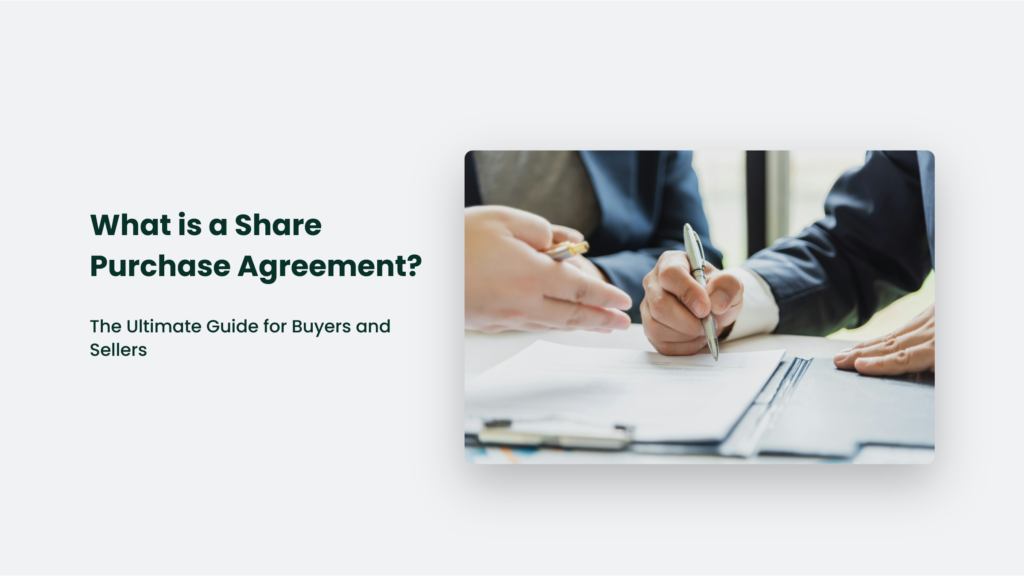Have you ever found yourself in a situation where you’re about to buy or sell shares in a company but are not quite sure how to formalize the deal? Enter the share purchase agreement (SPA)—the unsung hero of business transactions. It’s like the prenup of the corporate world, but instead of deciding who gets the dog in a divorce, it outlines who gets what when shares change hands.

What is a Share Purchase Agreement
At its core, a share purchase agreement is a legal document that outlines the terms and conditions for the sale and purchase of shares in a company. The roadmap guides both the buyer and seller through the transaction, ensuring everyone’s on the same page and protecting both parties’ interests.
Why You Need a Share Purchase Agreement
Imagine buying a car without any paperwork. Sounds risky, right? Now multiply that risk by about a thousand, and you’ll understand why you need a SPA when dealing with company shares. Here’s why they’re crucial:
- Legal Protection: It’s your safety net if things go south.
- Clarity: It spells out exactly what’s being bought and sold.
- Risk Allocation: It determines who’s responsible for what.
- Dispute Prevention: It’s your go-to document if disagreements arise.
The Anatomy of a Share Purchase Agreement
The Parties Involved
This section is the formal introduction of the key players in the transaction. It typically includes:
- Seller(s): Full legal names, addresses, and sometimes tax identification numbers of all individuals or entities selling shares.
- Buyer(s): Similar details for the purchasing party or parties.
- The Company: Details of the company whose shares are being sold, including its full legal name, registration number, and registered office address.
This section sets the stage for who’s accountable for what throughout the agreement.
The Shares Being Sold
Here’s where the agreement gets specific about the object of the sale:
- Number of Shares: The exact quantity being transferred.
- Share Class: Whether they’re common shares, preferred shares, or another class.
- Percentage Ownership: What portion of the company these shares represent.
- Share Certificates: Details of any physical certificates to be transferred.
- Rights Attached: Any specific voting rights, dividend rights, or other privileges associated with these shares.
The Purchase Price
This crucial section outlines the financial terms of the deal:
- Total Price: The agreed-upon value for the shares.
- Payment Method: Whether it’s cash, shares in another company, promissory notes, or a combination.
- Payment Schedule: If it’s not all paid at once, when are payments due?
- Earn-outs: Any additional payments based on the future performance of the company.
- Escrow Arrangements: If part of the payment is held back as security.
- Price Adjustments: Mechanisms for changing the price based on factors like working capital at closing.
Conditions Precedent
These are the hurdles that must be cleared before the deal can close:
- Regulatory Approvals: Any necessary green lights from government bodies.
- Third-Party Consents: Approvals needed from other stakeholders, like major clients or lenders.
- Due Diligence Completion: The buyer’s satisfaction with their investigation of the company.
- No Material Adverse Change: Assurance that the company hasn’t suffered any major setbacks since the agreement was signed.
- Financing: Confirmation that the buyer has secured necessary funds.
Representations and Warranties
It is where the seller vouches for the state of the company:
- Ownership and Authority: Confirmation that the seller can sell the shares.
- Financial Statements: Assurances about the accuracy of the company’s books.
- Legal Compliance: Statements that the company isn’t breaking any laws.
- Intellectual Property: Guarantees about ownership and non-infringement of IP.
- Material Contracts: Assurances about key business relationships.
- Litigation: Disclosure of any pending or threatened lawsuits.
- Tax Matters: Confirmations about the company’s tax compliance and liabilities.
Indemnification
This section acts as a safety net for the buyer:
- Scope: What types of losses are covered (e.g., breaches of warranties, undisclosed liabilities).
- Caps and Baskets: Limits on the seller’s liability, both overall and for small claims.
- Time Limits: How long the buyer have to make claims after closing?
- Procedure: How claims are to be made and defended.
- Remedies: Whether indemnification is the exclusive remedy or if other legal actions are possible.
- Set-off Rights: Whether the buyer can withhold future payments to cover claims.
By thoroughly addressing these key areas, a well-crafted SPA provides a clear roadmap for the transaction and helps protect both parties from potential pitfalls.
The Share Purchase Agreement Process: A Step-by-Step Guide
- Negotiation: Both parties hash out the terms.
- Due Diligence: The buyer does their homework on the company.
- Drafting: Lawyers put pen to paper (or fingers to keyboard).
- Review and Revision: Both sides fine-tune the agreement.
- Signing: The big moment arrives!
- Closing: Money changes hands, and shares are transferred
Share Purchase Agreement vs. Asset Purchase Agreement: The Showdown
While both involve buying parts of a business, they’re as different as apples and oranges. A share purchase agreement involves buying the company itself (through its shares), while an asset purchase agreement involves cherry-picking specific assets. According to a 2023 survey by Deloitte, 61% of executives prefer share purchases over asset purchases for acquisitions, citing simpler transaction structures and tax benefits.
The Devil’s in the Details: Key Clauses to Watch Out For
- Earn-out Provisions: These can make the final price a moving target.
- Non-compete Clauses: Ensure the seller doesn’t become your biggest competitor.
- Material Adverse Change (MAC) Clauses: Your escape hatch if something major goes wrong before closing.
The Pros and Cons of Share Purchase Agreements
Pros:
- Comprehensive protection for both parties
- Clear allocation of risks and responsibilities
- Continuity of business operations post-sale
Cons:
- It can be complex and time-consuming to negotiate
- It may require extensive due diligence
Conclusion: Wrapping Up the Share Purchase Agreement
A well-crafted share purchase agreement is like a good insurance policy – you hope you never need it, but you’re damn glad it’s there if you do. It’s the unsung hero of the business world, quietly ensuring that billions of dollars in transactions go smoothly every year.
Remember, whether you’re buying your first chunk of a startup or selling your multi-million dollar empire, a solid share purchase agreement is your best friend. It’s the difference between a handshake deal and a legally binding agreement that’ll stand up in court.
So, the next time you’re about to dive into a share purchase, take a deep breath, call your lawyer, and get ready to dive into the wonderful world of SPAs. Your future self (and your bank account) will thank you.
Frequently Asked Questions:
Do I really need a lawyer for a share purchase agreement?
Unless you enjoy playing Russian roulette with your finances, yes. A good lawyer is worth their weight in gold (or shares, in this case).
How long does it take to complete a share purchase agreement?
It varies, but typically anywhere from a few weeks to several months, depending on the complexity of the deal.
Can a share purchase agreement be amended after signing?
Yes, but it requires the consent of all parties involved. It’s like changing the rules mid-game – possible, but potentially messy.




